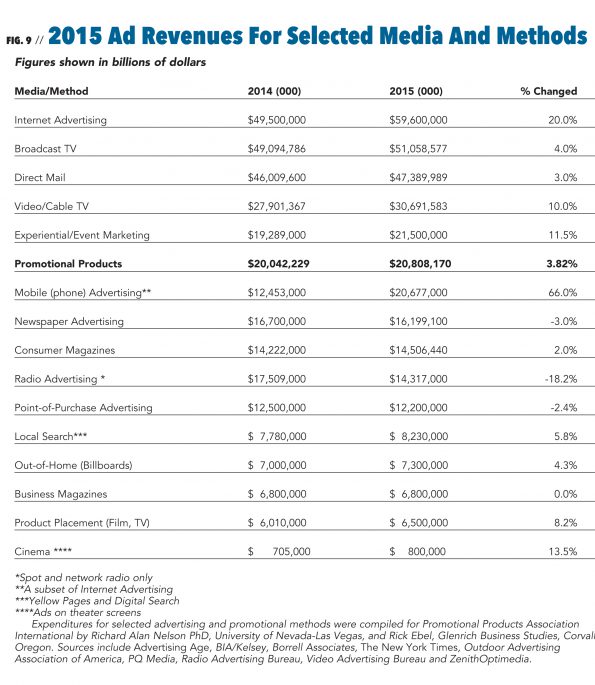Promotional Products Spend In 2015 Ranked Sixth Among All Media
By Richard Alan Nelson, Ph. D. and Rick Ebel
Although not a banner year for advertising revenue, in 2015 most media kept pace with what nowadays passes for inflation—but the digital platforms were booming.
Broadcast TV had a reasonably decent year with a four-percent gain (see table below), prompting CBS chief Leslie Moonves to crow and throw a dig at the rising digital opposition. “Everyone is now coming to the same conclusion that we came to a long time ago. Broadcast television remains the single best and most effective medium for advertising,” he claimed in an Advertising Age report. “Digital advertising sometimes lacks accuracy and credibility. As a result, there is a clear shift in advertising back to network television.”
But then, broadcast TV does have some special, crowd-pleasing assets working for it—like the Super Bowl. Back in 1978 you could buy a 30-second spot during the biggest game of the year for only $185,000. Well, those same 30 seconds at Super Bowl 50 earlier this year cost Anheuser-Busch a cool $5 million to convince viewers to try Michelob Ultra.
Sydney Ember, writing in The New York Times this spring, had an interesting take on digital advertising. Ember wrote: “The explosion of online ads, however, has led to the rising use of ad blockers and turned ‘advertising’ into something like a dirty word. So advertisers and publishers are now looking for ways to make online ads less like ads. Many in the industry are even changing the way they talk about ads.”
Seismic shifts in the media landscape have forced a sea change among media organizations resulting in mergers, and some organizations eliminating research departments and getting out of ad spend measurement entirely.
Some, like cable TV, an industry with modestly rising revenues, have merged with video. The decline in point-of-purchase business has eliminated the standalone trade group POPAI and created a merged group—A.R.E./POPAI, a new association dedicated to enhancing the total shopper experience. And you may have noticed skinnier Yellow Pages directories lately, if you use them at all. Reading the writing on the wall, the old Yellow Pages publishers’ group paired itself with digital to become a new entity, Local Search, and revenues are up almost six percent.
This year’s total ad spend is expected to rise, thanks to the summer Olympics and the U.S. presidential election, forecasts London-based ZenithOptimedia, and just about everyone else in that business. With electioneering requiring a lot of yard signs and bumper stickers, look for the presidential election to add $11.4 billion to 2016 ad revenues, predicts Virginia-based media consultant Borrell Associates. That’s 20 percent more than in the 2012 presidential race. Borrell reports that nearly half of the 2016 political dollars—$5.5 billion—will be spent on local and state elections. That can buy a lot of hot air.

Dr. Richard Nelson, RnelsonLV@gmail.com, is adjunct professor of integrated marketing communications at the Hank Greenspun School of Journalism and Media Studies at the University of Nevada-Las Vegas. Rick Ebel, glenrichbiz@gmail.com, is the former PPAI marketing communications director and now principal of Glenrich Business Studies, a business writing and research firm in Corvallis, Oregon.


